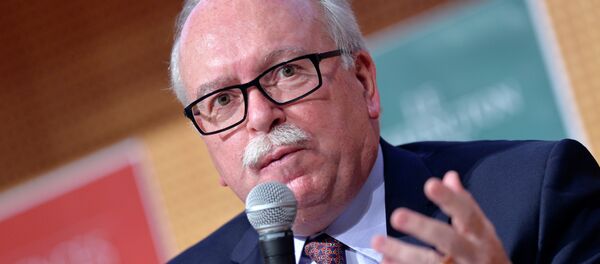The report from the Defense Personnel Security Research Center (PERSEREC) details over 200 Americans who’ve committed espionage against the US from 1947 to 2015. It was written by Katherine L. Herbig of Northrop Grumman Technology Services on behalf of the DOD, and breaks down three periods of espionage against the US: 1947-1979 (the early Cold War), 1980-1989 (the later Cold War), and 1990-2015 (the post-Soviet period).
READ MORE: Espionage Fears Spur US Army Base to Replace Chinese Security Cameras
Herbig’s report provides revealing statistics on the 67 Americans identified as having committed espionage-related offences in the post-Soviet era, noting how they were more racially and ethnically diverse than in the previous periods. Three quarters were civil servants, while the other quarter were military, and increasingly they were contractors, did not hold intelligence-related jobs and/or did not have security clearances. This may be a reflection of the classification craze in the post-Cold War period, where even mundane government officials are handling documents classified as ‘secret’ or higher.
In total, three quarters of the post-Cold War spies were successful in passing information to their handlers, while only one quarter were intercepted by counter-intelligence officials before they could betray information. 60% were volunteers while 40% were recruited, mostly by foreign intelligence services. The volunteers mostly just walked into foreign embassies and offered their services. Unsurprisingly, of those who were were successful a lower proportion of them gave information to Russia than during the Cold War period. 68% of the spies received no payment at all.
‘An Attempt at Classic Espionage’
One of the more prominent examples of a post-Cold War spy is Glenn Duffie Shriver, a naive young man who was recruited by the Chinese government while working in China. Herbig’s report notes:
Shriver failed in his mission because he blew the mandatory polygraph all CIA applicants have to take, and was arrested in July 2010 after boarding a plane to South Korea. He plead guilty to conspiracy to commit unlawful conveyance of national defense information and was sentenced to four years in prison. In 2014 the FBI spent $650,000 producing a film about Shriver called Game of Pawns, to be shown on college campuses as a warning to other young people about the risks of working abroad and being approached by foreign governments.
‘He never saw a classified document or gained access to any classified information, and although not acknowledged, it is likely that the CIA saw through his lies well before the interviews and the polygraph exam.’
Spies vs Leakers vs Whisteblowers?
When it comes to the personal reasons behind espionage and other similar activities Herbig’s report draws no meaningful distinction between being a spy, a leaker and a whistleblower. While acknowledging that money is the most common motive, the Pentagon document records that only 28% of the post-Cold War spies were drawn in by cash, down from 41% and 45% for the early Cold War and late Cold War periods.
READ MORE: US Senator May Have Been Target of US Intelligence Community Espionage
The report fails to recognize that leaking has become commonplace in modern politics, with a vast number of news stories attributing information to anonymous government insiders and unpublished documents. Sputnik spoke to the editor of Cryptome John Young, who commented, ‘The most ubiquitous leakers are government officials, but then they are also the most ubiquitous spies.’
One criticism of the report is that it conflates whistleblowers such as Chelsea Manning and John Kiriakou with spies like Shriver, Robert Hanssen and Aldrich Ames. As Young observed, ‘Spies are what government officials call government opponents.’ Sputnik spoke exclusively with Steven Aftergood, director of the Federation of American Scientists Project on Government Secrey. He took issue with the PERSEREC report including leaking as a kind of espionage, commenting:
‘I think the report makes a conceptual error by including leaks in its treatment of espionage. While both activities involve unauthorized transfer or disclosure of classified information, they are different in every other important respect – motivation, intended audience, intended outcome, etc.’
He went on to draw a key distinction between whistleblowers and spies, saying:
‘Spies like Hanssen were driven by a desire for personal gain. Manning and others sought, rightly or wrongly, to address what they saw as official misconduct, not to benefit themselves. These are two different phenomena, requiring different policy responses. But the DoD report blurs the difference.’
Strange Omissions
Despite insisting that there is no difference between spies, leakers and whistleblowers, Herbig’s report makes some odd omissions. One is Daniel Ellsberg – widely recognised as the principal leaker of the Pentagon Papers. While the espionage charges against Ellsberg were ultimately dismissed there is no doubt that he did leak classified information to the media. If the report were only including people who have actually been convicted of espionage then it should not have included Edward Snowden, who has never been put on trial so the charges against him remain legally unproven either way.
According to FBI documents Smyth was recruited by Milchan to set up MILCO, a front company that would purchase the nuclear triggers and then secretly export them to Heli Trading in Israel, all using money from the Israeli Ministry of Defense. The smuggling operation was revealed after a break-in at MILCO which was investigated by the FBI. The Bureau quickly figured out what Smyth was doing and charged him with with exporting arms illegally, causing him to flee before his trial. After many years on the run he was finally brought to ground in 2001 and sentenced to 40 months in prison.
It is not clear why neither Ellsberg nor Smyth’s name and story appear in the PERSEREC report, but Young suggested that they were deliberate omissions. He commented:
‘Some are omitted to foster the notion that government leaking aka spying is less pervasive than it actually is, as well as imply that not every "spy" or "leaker" is caught.’






